Identifying and Destroying Pest Eggs on Vegetable Plants
by Sara Daleski, Fairfax Master Gardener
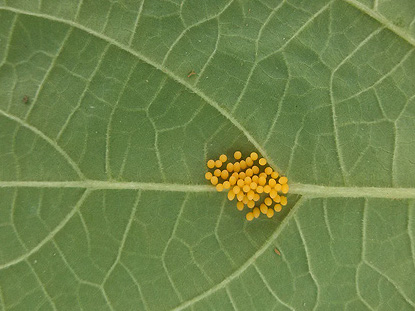
Bean beetle eggs on underside of leaf
Many years ago, we started a plot in a community garden. The first thing I learned is that the pest issues are compounded by the concentration and variety of plants. The small plot size also makes strategies like crop rotation difficult to do, properly. I’m also at the mercy of my neighbors’ planting and weeding efforts (or lack thereof).
One of the things that does help is to check my plants frequently for the eggs of vegetable pests. If I can destroy eggs before they hatch, I avoid a lot of problems. Insect larvae have a harder time moving from plot to plot to do damage. Destroying eggs can also be helpful for home gardeners trying to prevent pest populations from becoming established. I started the list below to help me recognize the eggs of vegetable crop pests I find most frequently in my Northern Virginia vegetable garden. This list is based on my observations and comprises eggs I see on leaves or stems of vegetable plants in my garden plot.
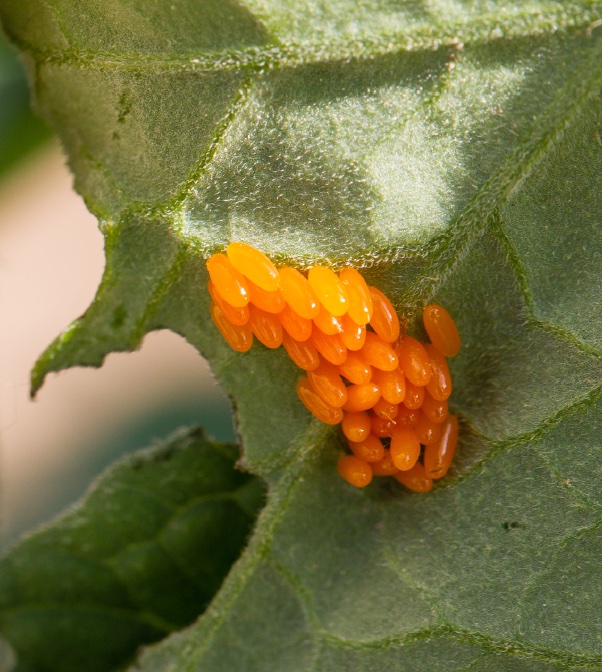
Colorado Potato Beetle eggs
I usually take a long wooden spoon to the garden plot with me and use it to help me reach in and move leaves to search plants for insect eggs. My husband and I have different strategies for destroying them. He isn’t squeamish and just squashes eggs with his fingers. I usually wear gloves for that, or scrape clusters into a jar of soapy water. Where leaves are fragile or eggs are very small, I sometimes use painter’s tape or small pieces of duct tape to remove eggs (like those of vine borers) from stems and leaves. You can quickly tap the eggs with tape and then throw them away. If you are careful, the tape can do less damage to fragile plants than scraping or squashing.
Looking for eggs also helps you identify other emerging issues with your vegetable plants. To me, that is time well spent “getting to know” my garden.
Tips To Identify Insect Eggs
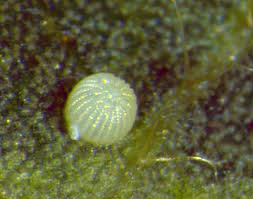
Corn earworm eggs
Bean Beetle Epilachna varivestis
These eggs are tiny round, yellow clusters. When first laid, they are pale yellow and then darken over time.
Mexican bean beetles usually lay their eggs on the underside of leaves, but you can find them on leaf surfaces as well. Look for these eggs beginning in July. If you miss them, you will soon see the yellow larvae crawling on your plants.
Colorado Potato Beetle Leptinotarsa decemlineata
One female can lay hundreds of these eggs into oval clusters. They are bright orange and are located on the underside of leaves. Begin to look for them in May.
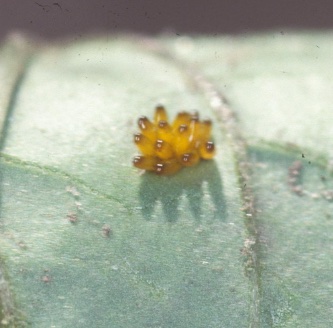
Cucumber beetle eggs
Corn Earworm Helicoverpa zea
Females lay single eggs instead of clusters. These eggs are small and round, with ridges that radiate from the top. Look for them on upper leaf surfaces in May through August.
Cucumber Beetle Diabrotica undecimpunctata (spotted beetle), or Acalymma vittatum (striped beetle)
These eggs form yellow to orange oval clusters, with hundreds of eggs in each cluster. Eggs are usually laid near the base of cucurbits or lower leaves, since they need moisture to survive. Look for them beginning in June.
Leaf Footed Bug Leptoglossus phyllopus
These egg masses are very distinctive and easy to recognize. They are gold to golden brown and laid in a single column or row. Eggs will be found along stems or leaf ribs. Look for them in the spring.
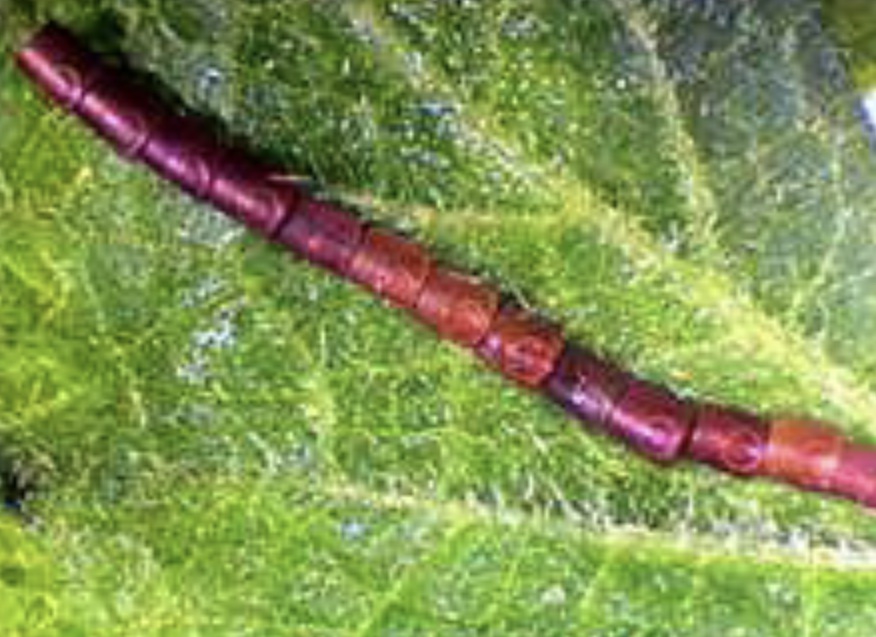
Leaf footed bug eggs
Squash Bug Anasa tristis
These orange-brown eggs are laid in oval clusters. They begin as a lighter color and darken over time.
Eggs are usually on leaves but can also be on the veins of stems. Look for them in early June through mid-summer.
Squash Vine Borer Melittia cucurbitae
These eggs are flat, dark coppery disks, usually one egg or a small cluster. You can tell them apart from squash bugs because they are single and flat instead of round. They are usually laid near the base of the plant, but you will also find them on vines and leaves. Look for them beginning in late May until early June, continuing through August.
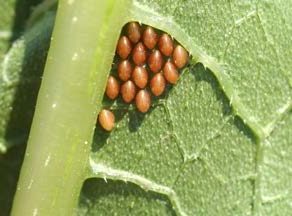
Squash bug eggs
Thrip Thysanoptera
Onion thrip eggs look like very tiny white-yellow beans. They are laid in clusters or masses on the underside of leaves. Look for them beginning in early summer.
Tomato Hornworm Manduca quinquemaculata
These eggs are light green, round and smooth. You will only find single eggs, so look closely.
Eggs are located on upper or lower leaf surfaces. Look for them beginning in late spring.

Squash vine borer eggs

Onion Thrip Eggs

Hormworm eggs
-
References
- Beat the Mexican Bean Beetle, Leslie Moore, Fairfaxgardening.org
- Colorado Potato Beetle, Kuhar, et al., Virginia Cooperative Extension, 444-012
- Corn Earworm on Vegetables, Kuhar, et al., Virginia Cooperative Extension, 3103-1537 (ENTO -312NP)
- Striped Cucumber Beetle and Spotted Cucumber Beetle, Utah State University Extension
- Leaf-footed bugs are running amuck on vegetables, Thomas Kuhar, Ag Pest and Crop Advisory, Virginia Cooperative Extension